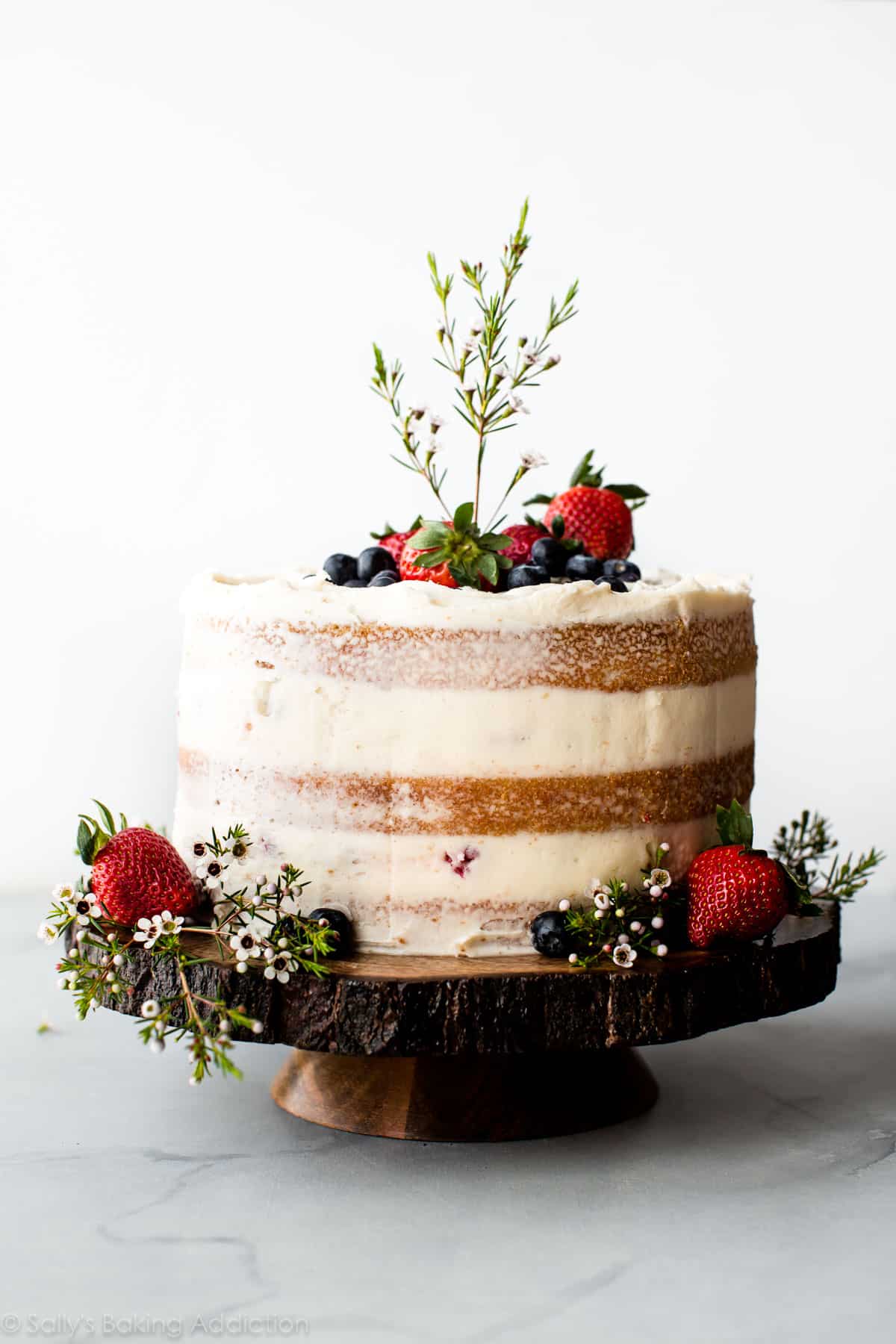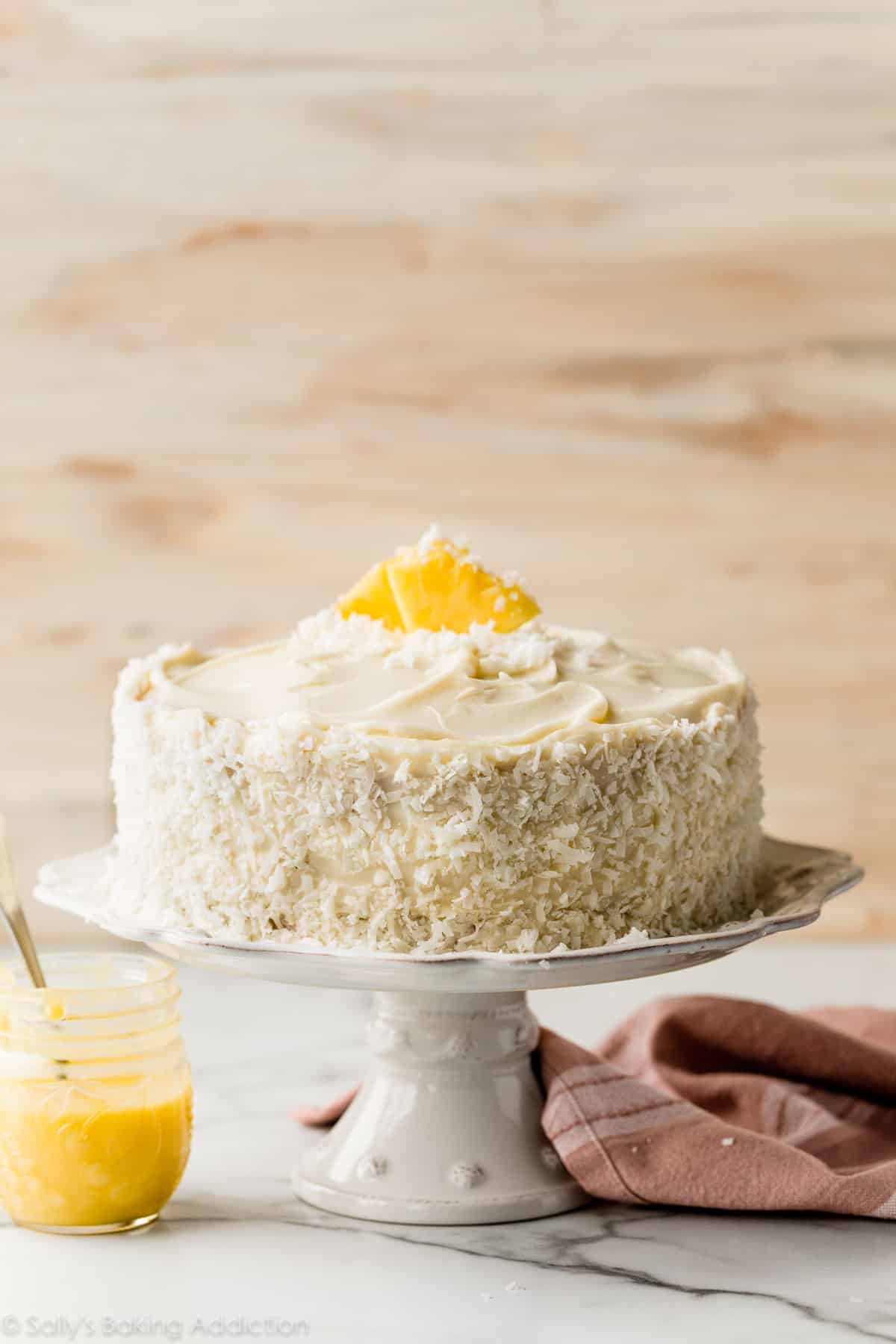Be taught the fundamentals of learn how to assemble and enhance a layer cake with this detailed publish as your information. I observe the identical steps whether or not I’m making a 2-layer, 3-layer, or 4-layer cake, and whether or not it’s a 6-inch cake or a 9-inch cake. Watch the video tutorial to see me reveal each step.
Pictured right here is my 3-layer 9-inch vanilla cake with vanilla buttercream.
I do know making layer truffles can appear intimidating, so at present I’m serving to to make the method a bit simpler for you. Bookmark this learn how to assemble a layer cake information for any time you’re serving a layer cake, whether or not it’s a 3-layer carrot cake, 2-layer chocolate cake, or smaller 6-inch cake.
Let’s dive proper in.
Assemble a Layer Cake Video
Useful Instruments for Assembling Layer Desserts
See this publish on 10 important cake baking and adorning instruments for extra.

Step 1: Stage the Cake Layers
It’s essential your cake layers are stage, so your layer cake has stability. Be certain the truffles are utterly cool earlier than you stage them. You need to use a instrument known as a cake leveler, however I normally simply use a serrated knife. Slice off the domed high so the highest is flat. You may discard the bit you sliced off, or crumble it up and use it as garnish on high or across the cake. (Or benefit from the cake crumbles over ice cream—my favourite!)

Step 2: Stacking
Determine on the frosting you need to use to your cake. Most of my layer cake recipes embrace the frosting recipe you’ll want for the cake. American buttercream or Swiss meringue buttercream are my 2 high decisions for layer truffles. If utilizing cream cheese frosting, I discover it useful to refrigerate it for at the very least 1 hour earlier than utilizing, because it isn’t as sturdy and secure as buttercream.
A cake turntable makes it simpler to frost the perimeters. I normally use about 3/4 to 1 cup of frosting between every cake layer. To unfold it, use an offset spatula, straight icing spatula, or a daily knife. Unfold the frosting all the best way to the perimeters.
Place the second cake layer the wrong way up. This creates a flat base for the highest layer to take a seat on. (In case your cake is simply 2 layers, you’ll be able to place the 2nd (high) layer the wrong way up OR proper facet up.) Examine to verify the cake layer is stage all the best way round. Then add one other 3/4–1 cup of frosting on high, once more spreading it to the perimeters.


Place the highest layer on high. You may place it the wrong way up once more if you need your cake to have a really straight look on the perimeters and a wonderfully flat high, however I normally place the highest layer right-side-up, in order that there’s a little bit of a curve to the perimeters.


Step 3: Crumb Coat
It is a very skinny layer of frosting utilized to the highest and sides of the cake, which helps lock in any free crumbs and provides stability to the completed layer cake. It additionally makes a pleasant easy base for frosting and adorning. Use about one other cup of frosting (240g) for that. Begin transferring the frosting from the highest down the perimeters. Go across the sides with a bench scraper—it’s a very helpful instrument that makes straightforward work of smoothing out the perimeters. Refrigerate for 20 minutes to an hour to set the crumb coat.


Step 4: Ending & Adorning
As soon as your crumb coat has set, you’ll be able to end the cake with a thicker layer of frosting. I like to recommend a straight spatula for this. You need to use your bench scraper once more for easy sides, however I like a bit texture.


Should you used a cake turntable and need to switch your cake to a serving platter or cake stand, it’s useful to have a cake lifter instrument and a second set of fingers.
In case you have additional frosting, you need to use a piping bag and tip and add some ornament. Right here I used the Wilton 1M tip to pipe a shell border across the high and backside of the cake.


Relating to cake adorning, I prefer to hold issues easy. As a lot as I like all these cake artists on the market and marvel at their creations, I settle for that cake artistry is just not in my ability set! BUT there are methods you may make a wonderful layer cake, even in the event you lack creative ability.
Take this rustic-chic bare cake, for instance. Garnishing with recent florals and berries provides easy, refined class—no piping suggestions, fondant, or modeling chocolate required.


A easy garnish of recent berries and mint is one in all my favourite methods to garnish a cake, as a result of it’s so EASY, but takes the cake to the subsequent stage.
You may as well garnish with an ingredient used within the cake, equivalent to toasted nuts on high of this carrot cake, or coconut and recent pineapple on high of this pineapple coconut cake.


Extra Cake Baking & Adorning Tutorials
PrintDescription
Be taught the fundamentals of learn how to assemble and enhance a layer cake with this detailed information. I observe the identical steps whether or not I’m making a 2-layer, 3-layer, or 4-layer cake, and whether or not it’s a 6-inch cake or a 9-inch cake. Watch the video tutorial to see me reveal each step.
- Stage the Cake Layers: It’s essential your cake layers are stage, so your layer cake has stability. Be certain the truffles are utterly cool earlier than you stage them. You need to use a instrument known as a cake leveler or use a serrated knife. Slice off the domed high of your truffles so the highest is flat. You may discard the bit you sliced off, or crumble it up and use it as garnish on high or across the cake. (Or benefit from the cake crumbles over ice cream—my favourite!)
- Stack the Layers: Place the underside layer proper facet up on a cake turntable or cake stand. Place 3/4 to 1 cup of frosting (wherever between 180–240g) on high. Utilizing an offset spatula, straight spatula, or a daily knife, unfold the frosting all the best way to the perimeters of the cake. Place the second cake layer the wrong way up evenly on high, which creates a flat base for the highest layer to take a seat on. (*See finish of this step if you’re making a 2-layer cake.) Examine to verify it’s stage all the best way round. Then add one other 3/4–1 cup of frosting (180–240g) on high, once more spreading it to the perimeters. Place the highest layer on high. You may place it the wrong way up once more if you need your cake to have a really straight look on the perimeters and a wonderfully flat high, or you’ll be able to place it proper facet as much as have a little bit of a rounded edge. *In case your cake is simply 2 layers, the 2nd/high layer may be the wrong way up or proper facet up, relying if you need a straight edge or rounded edge on high of your cake.
- Add the Crumb Coat: A crumb coat is an especially skinny layer of frosting utilized to the highest and sides of the cake, which helps lock in any free crumbs and provides stability to the completed layer cake. For a 3-layer cake, use about 1 cup of frosting (240g) for it. For a 2-layer cake, round 3/4 cup (180g). Unfold it all around the high and sides. To easy out the perimeters, run a bench scraper across the cake. Refrigerate uncovered for 20 minutes to 1 hour to set the crumb coat.
- End Adorning the Cake: As soon as your crumb coat has set, end the cake with a thicker layer of frosting utilizing a straight icing spatula. You need to use your bench scraper once more for easy sides, or hold the perimeters textured as proven within the video. Should you used a cake turntable and need to switch your cake to a serving platter or cake stand, it’s useful to have a cake lifter instrument and a second set of fingers to elevate and switch it. In case you have some additional frosting, you’ll be able to fill a piping bag and add some ornament. Right here I used the Wilton 1M tip to pipe a shell border across the high and backside of the cake.
- When you’ve gotten completed adorning your cake, it’s finest to refrigerate it uncovered for at the very least 20 minutes earlier than slicing and serving. Relying on the cake, you’ll be able to refrigerate it for as much as 4 to six hours. To retailer leftover cake or in the event you plan to move the cake, I like to recommend a cake provider as a result of it retains the cake recent with out touching or smearing the frosting.
Notes
- Particular Instruments (affiliate hyperlinks): Serrated Knife or Cake Leveler Instrument | Cake Turntable | Silicone Spatula | Small Offset Spatula | Giant Straight Spatula | Bench Scraper | Cake Lifter | Cake Stand (like this one or this one) | Piping Bag (Reusable or Disposable) | Wilton 1M Piping Tip | Cake Provider
- Quantity of Frosting: On the whole, for an 8-inch or 9-inch spherical cake, you’ll use 3/4–1 cup (180–240g) of frosting between every cake layer, plus one other 3/4–1 cup for the crumb coat. After that, the quantity of frosting relies on how thick you need the outside layer and in the event you’ll need to add piping particulars to the cake. I normally use 4.5 cups (1080g) on a 2-layer 8- or 9-inch cake, and 5–6 cups (1200–1440g) on a 3-layer 8- or 9-inch cake. For a 3-layer 6-inch cake, use about 1/2 cup (120g) of frosting between every layer, 1/2 cup for the crumb coat (give or take), and 1–1.5 cups across the high and sides to complete (3.5–4 cups (840–960g complete).


